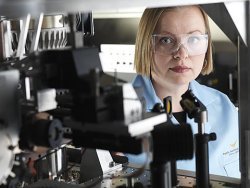Sep 9 2009
Tiny particles are pivotal to climate change, public health, and nanotechnology. A significant fraction of these particles are aspherical, yet scientists must routinely assume the particles are spherical to interpret many measurements of particle properties. To determine the true shape of particles, experts at Pacific Northwest National Laboratory and Imre Consulting devised SPLAT II, a single particle mass spectrometer that provides extremely precise particle measurements.
 A paper on SPLAT II is the second most cited in Aerosol Science and Technology.
A paper on SPLAT II is the second most cited in Aerosol Science and Technology.
The 2006 paper on SPLAT II is the second most cited in Aerosol Science and Technology, the 4th ranked journal in mechanical engineering and the official journal of the American Association for Aerosol Research.
Particle properties and behavior are tightly linked to their shape. For example, how much light a particle scatters, in what spatial distribution, and polarization is closely related to particle shape. Before these measurements it was assumed that the shape of particles of different types is size independent. Measurements from the SPLAT II showed that the dynamic shape factor of ammonium sulfate and sodium chloride particles increase with particle size.
SPLAT II provides measurements of particles with unprecedented sensitivity and precision. By combining SPLAT II with another instrument, scientists can simultaneously measure various properties about each particle, including vacuum aerodynamic diameter, mobility diameter, dynamic shape factor, and effective density.
Scientists regularly use SPLAT II to learn more about particles. For example, the instrument was part of a massive field campaign in northern Alaska aimed to improve our understanding of the relationship between particle size and composition and their ability to form warm and ice clouds.
SPLAT II is on its way to another field campaign to quantify the properties of exhaust particles in a joint project with General Motors and the University of Wisconsin.
More information: Zelenyuk A, Y Cai, and D Imre. 2006. "From agglomerates of spheres to irregularly shaped particles: Determination of dynamic shape factors from measurements of mobility and vacuum aerodynamic diameters." Aerosol Science and Technology 40(3):197-217.